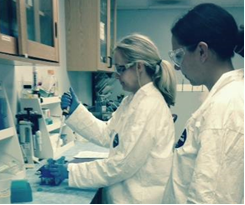NOAA’s harmful algal bloomAnalytical Response Team has teamed with Hollings Marine Lab partner, the National Institute of Standards and Technology (NIST), to provide training for a NIST International Fellow on algal toxin detection in marine wildlife. Dr. Rute Costa of the Marine Animal Rehabilitation Centre in Figueira da Foz, Portugal, is nearing completion of this four-week training at the NCCOS Center for Coastal Environmental Health and Biomolecular Research.

The Marine Animal Rehabilitation Centre documents strandings and rehabilitates stranded marine birds, turtles, and cetaceans from the west coast of Portugal. Although the Iberian coastal ecosystem is known to experience episodic harmful algal blooms, little information is available on the impacts of algal toxins on marine wildlife in this region. Dr. Costa’s expertise is in the impacts of anthropogenic contaminants on birds. Her training with NCCOS will enable her to broaden her scope of investigations to include a full suite of algal toxins. NOAA’s Analytical Response Team has been instrumental in establishing the link between harmful algal blooms and wildlife mortalities in U.S. coastal waters. Since 1991, 60 marine mammal unusual mortality events have been investigated. Forty percent of those with known causes are attributed to harmful algal blooms.
For more information, contact Fran.VanDolah@noaa.gov.
